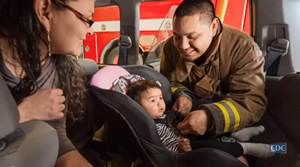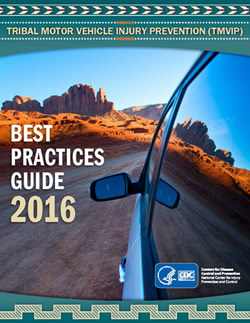Tribal Road Safety: Get the Facts
The Problem
How big is the problem?
- Unintentional injuries are the leading cause of death for AI/AN ages 1 to 44 and the third leading cause of death overall.1
- Motor vehicle crashes are a leading cause of unintentional injury death for AI/AN. Adult (aged ≥20 years) motor vehicle-related death rates for AI/AN are more than twice that of non-Hispanic whites or blacks.1
- Among AI/AN aged 1—19 years, motor vehicle crashes are the leading cause of unintentional injury death, followed by drowning and poisoning.1
- Among infants less than one year of age, the motor vehicle traffic death rate among AI/AN is 8 times higher than that of non-Hispanic whites.2
Risk Groups
Who is most at risk?
Children

Among AI/AN 19 years and younger, motor vehicle crashes are the leading cause of unintentional injury-related death, followed by drowning and poisoning.
Among all racial/ethnic groups in the United States, AI/AN children experience the highest fatal and nonfatal injury rates.1-3 AI/AN ages 19 years and younger are at greater risk of preventable injury-related deaths than any other racial/ethnic group. Compared with non-Hispanic blacks and whites, this group has the highest injury-related death rates for motor vehicle crashes, pedestrian events, and suicide. Rates for these causes are two to three times greater than rates for non-Hispanic whites the same age.1
Males
AI/AN as a group are at increased risk of injury, but AI/AN males are at especially high risk. Compared with their female counterparts, non-Hispanic AI/AN males aged 20 years and older are twice as likely to die from a motor vehicle crash and 3.8 times more likely to die from pedestrian-related injury.1
Major Risk Factors
What are the major risk factors?

Low seat belt use
- According to the National Highway Traffic Safety Administration (NHTSA) and the Bureau of Indian Affairs Indian Highway Safety Program, the 2016 overall rate of seat belt use across 17 reservations is 77.7%. Belt use varies greatly across reservations, ranging from a low of 49.0% to a high of 92.6%.4
- Seventy percent of AI/AN passenger vehicle occupants who died in motor vehicle crashes were not wearing a seat belt at the time of the fatal crash, compared with the national proportion of 48% in 2015.5
Low child safety seat use
- Though AI/AN child safety and booster seat use rates vary greatly, AI/AN use rates are much lower than that of other racial groups.6 In a study of six Northwest tribes, proper restraint use among AI/AN children aged 7 years and younger ranged from 23% to 79%.8 A nationally representative study in 2015 found proper restraint use among children aged ≤7 years ranged from 63% to 87%.7
Alcohol impaired driving
- AI/AN have a high prevalence of alcohol-impaired driving and the highest alcohol-related motor vehicle death rates among racial/ethnic populations.9,10 Nearly two thirds (64%) of motor vehicle deaths across 6 tribes during 2009-2014 were alcohol-impaired (unpublished data), compared with the national proportion of 31% in 2014.11
Prevention
How can injuries be prevented?
 Proven and effective strategies to reduce motor vehicle crash-related injuries and deaths are well established; these include use of occupant restraints, primary enforcement seat belt laws, high visibility enforcement, and blood alcohol concentration laws. Effective strategies to reduce motor vehicle crash injuries and deaths can be successfully tailored to tribal communities.
Proven and effective strategies to reduce motor vehicle crash-related injuries and deaths are well established; these include use of occupant restraints, primary enforcement seat belt laws, high visibility enforcement, and blood alcohol concentration laws. Effective strategies to reduce motor vehicle crash injuries and deaths can be successfully tailored to tribal communities.
Child safety seats
- Child safety seat use reduces the risk of death in passenger cars by 71% for infants, and by 54% for toddlers ages 1 to 4 years.12,13 Booster seat use reduces the risk for serious injury by 45% for children aged 4–8 years when compared with seat belt use alone.14
- There is strong evidence that child safety seat laws, safety seat distribution and education programs, community-wide education and enforcement campaigns, and incentive-plus-education programs are effective in increasing child safety seat use.15
Seat belt use
- Seat belt use reduces the risk for death and serious injury by about half.16,17
- There is strong evidence that seat belt use laws, especially primary enforcement laws, and enhanced enforcement campaigns are effective in increasing seat belt use.18
Impaired driving
Proven measures to reduce alcohol-impaired driving include:
- Enforcing 0.08% BAC laws, minimum legal drinking age laws and zero tolerance laws for drivers younger than 21 years old.19
- Utilizing sobriety checkpoints. DUI checkpoints are effective in reducing alcohol-related crashes and death by approximately 17-25%.20
- Using multi-faceted community-based approaches to alcohol control and DUI prevention.21,22
Teen drivers
- There are proven methods to helping teens become safer drivers. Graduated driver licensing (GDL) systems are designed to delay full licensure while allowing teens to get their initial driving experience under low-risk conditions.
- Research suggests that the most comprehensive GDL programs are associated with reductions of 38% and 40% in fatal and injury crashes, respectively, among 16-year-old drivers.23
Additional Resources
Related Pages
Additional Resources
References
- Centers for Disease Control and Prevention, National Center for Injury Prevention and Control. Web-Based Injury Statistics Query and Reporting System (WISQARS)(online) {cited 2017 October 30}.
- Murphy T, Pokhrel P, Worthington A, Billie H, Sewell M, Bill N. Unintentional Injury Mortality Among American Indians and Alaska Natives in the United States, 1990-2009. AJPH 2014:104-S3:S470-S480
- Wallace LJD, Patel R, Dellinger A. Injury mortality among American Indian and Alaska Native Children and Youth — United States, 1989–1998. MMWR 2003;52(30):697–701.
- Department of Transportation (US), National Highway Traffic Safety Administration (NHTSA). Bureau of Indian Affairs Indian Highway Safety Program. Final Report – 2016 Safety Belt Use Estimate for the Indian Nations. September 2016.
- Department of Transportation (US), National Highway Traffic Safety Administration (NHTSA). Fatality Analysis Reporting System (FARS) (online) (2010-2014) {cited 2017 October 30}
- LeTourneau RJ, CE Crump, Bowling JM, Kuklinski DM, Allen CW. Ride Safe: A Child Passenger Safety Program for American Indian and Alaska Native Children. Maternal Child Heath 2008. DOI 10.1007/s10995-008-0332-6
- Department of Transportation (US), National Highway Traffic Safety Administration (NHTSA). The 2015 National Survey of the Use of Booster Seats. September 2016 DOT HS 812 309
- Lapidus JA, Smith NH, Lutz T, Ebel BE. Trends and correlates of child passenger restraint use in six Northwest Tribes: The Native children always ride safe (Native CARS) project. American Journal of Public Health 2013;103(2);355-61
- Voas RB, Tippets AS, Fisher DA. Ethnicity and Alcohol related fatalities: 1990 to 1994. Landover, MD: Pacific Institute for Research and Evaluation; 2000. Report no. DOT HS 809 068
- Naimi TS, Cobb N, Boyd D, Jarman DW, Espey D, Snesrud P, Chavez P. Alcohol-Attributable Deaths and Years of Potential Life Lost Among American Indians and Alaska Natives – United States, 2001-2005. MMWR 2008;57(34):938-941.
- Department of Transportation (US), National Highway Traffic Safety Administration (NHTSA). Traffic Safety Facts: 2014 Data: Alcohol-Impaired-Driving. December 2015 DOT HS 812 231
- Kahane CJ. An evaluation of child passenger safety: the effectiveness and benefits of safety seats. Washington, DC: National Highway Traffic Safety Administration; 1986. Available at http://www-nrd.nhtsa.dot.gov/pubs/806890.pdf
- National Highway Traffic Safety Administration. Revised estimates of child restraint effectiveness. Washington, DC: US Department of Transportation, National Highway Traffic Safety Administration; 1996. Available at http://www-nrd.nhtsa.dot.gov/pubs/96855.pdf
- Arbogast KB, Jermakian JS, Kallan MJ, Durbin DR. Effectiveness of belt positioning booster seats: an updated assessment. Pediatrics 2009;124;1281–6.
- Zaza S, Sleet DA, Thompson RS, et al. Task Force on Community Preventive Services. Reviews of evidence regarding interventions to increase use of child safety seats. American Journal of Preventive Medicine. 2001;21(4S):31-47
- Kahane, C.J. Lives saved by vehicle safety technologies and associated Federal Motor Vehicle Safety Standards, 1960 to 2012 – Passenger cars and LTVs. Washington, DC: National Highway Traffic Safety Administration. 2015. Available at www.nrd.nhtsa.dot.gov/pubs/812069.pdf.
- National Highway Traffic Safety Administration (NHTSA). Final regulatory impact analysis amendment to Federal Motor Vehicle Safety Standard 208. Passenger car front seat occupant protection. Washington, DC: US Department of Transportation, National Highway Traffic Safety Administration. 1984. Publication no. DOT-HS-806-572.
- Motor-Vehicle Occupant Injury: Strategies for Increasing Use of Child Safety Seats, Increasing Use of Safety Belts, and Reducing Alcohol-Impaired Driving. A Report on Recommendations of the Task Force on Community Preventive Services. MMWR. 2001;50 (no.RR-7) (2)
- Shults RA, Sleet DA, Elder RW, Ryan GW, Sehgal M. Association between state-level drinking and driving countermeasures and self-reported alcohol-impaired driving. Injury Prevention 2002;8:106—10.
- Elder RW, Shults RA, Sleet DA, et al. Effectiveness of sobriety checkpoints for reducing alcohol-involved crashes. Traffic Injury Prevention 2002;3:266-74.
- DeJong W. Hingson R. Strategies to reduce driving under the influence of alcohol. Annual Review of Public Health 1998;19:359-78.
- Holder HD, Gruenewald PJ, Ponicki WR, Treno AJ, Grube JW, Saltz RF, et al. Effect of community-based interventions on high-risk drinking and alcohol-related injuries. Journal of the American Medical Association 2000;284:2341-7.
- Baker SP, Chen L, Li G. Nationwide review of graduated driver licensing. Washington (DC): AAA Foundation for Traffic Safety; 2007. Available at http://www.aaafoundation.org/pdf/NationwideReviewOfGDL.pdf
- Page last reviewed: January 30, 2017
- Page last updated: January 30, 2017
- Content source:
- Centers for Disease Control and Prevention,
- National Center for Injury Prevention and Control,
- Division of Unintentional Injury Prevention


 ShareCompartir
ShareCompartir

